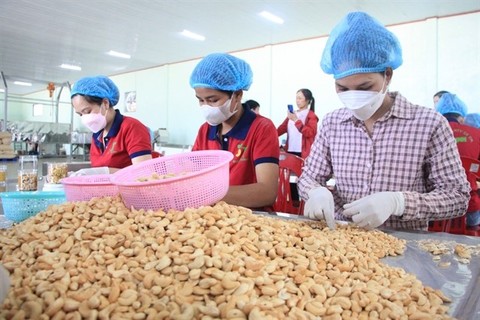
Processing cashews for export at a factory in Bình Phước Province. Việt Nam's cashew nut exports in the first eight months of 2024 reached 486,470 tonnes. — VNA/VNS Photo
Cashew nuts are one of the exports which have created a large market for Việt Nam, however the industry faces the risk of trade deficit due to higher raw material prices.
Exports of cashews were up 22.9 per cent in volume and 21.8 per cent in turnover year-on-year, according to the General Department of Customs, with an average price per tonne of US$5,706.
Notably, the export turnover of cashew nuts still maintained growth, but the gap between the export value and the import turnover of raw materials has gradually narrowed.
In 2023, the export turnover of cashew nuts reached $3.64 billion, while the import of raw materials stood at $3.1 billion. The industry achieved a trade surplus of $500 million.
In the first eight months of this year, the cashew industry spent about $2.7 billion to import raw materials for processing, approaching the import value of last year.
"This figure accurately reflects the current situation of the cashew industry," said Vũ Thái Sơn, chairman of Bình Phước Cashew Association and general director of Long Sơn Company.
Việt Nam is the world's leading country in processing cashew nuts. It has a large number of factories, but the domestic raw material area is reducing, only meeting about 10 - 12 per cent of the demand for raw cashew nuts for those factories. Most of the raw materials have to be imported from Africa and Cambodia, according to Sơn.
A few years ago, the raw cashew nut supply was quite large, however this year supplies have fallen sharply due to drought.
In addition, African countries' export of raw cashew nuts has also tightened, so the selling price of raw cashew nuts has increased by 40-50 per cent.
The growth rate of the export price of cashew nuts is not significant, so many enterprises have suffered heavy losses.
According to the Việt Nam Cashew Association (VINACAS), Việt Nam's cashew tree growing area is gradually decreasing year on year, from 440,000ha in 2007 to 302,500ha in the 2019-2020 crop year, with an output of about 339,800 tonnes.
In 2024, the total cashew area nationwide will remain at 305,000ha, with estimated output of raw cashew nuts at 370,000 tonnes. With low incomes and greater competition from imported raw cashew nuts, the domestic growers in some areas have switched to other crops with higher value.
At the beginning of this year, the price of cashew nuts skyrocketed - suppliers demanded price increases or cancelled contracts, causing a lack of raw material for domestic cashew factories.
Bạch Khánh Nhựt, VINACAS permanent vice chairman, said every year Việt Nam imported more than 2.5 million tonnes of raw cashews, of which about 1.7 million tonnes are sourced from Africa, mainly west Africa.
This year, El Nino impacted cashew production across Africa, including the Ivory Coast, leading to low output and high prices.
Raw material exporters from Africa had increased the price of the contracts that had previously been signed with Vietnamese enterprises, by 40-50 per cent to $1,500-$1,700 per tonne.
For many years, Việt Nam had led the global cashew supply chain, but that position was shaky and would certainly be lost if it did not change in time.
Small and medium sized factories must compete with large export processing enterprises, mainly foreign direct investment (FDI) factories, in purchasing raw cashew nuts. SMEs could face bankruptcy if things do not change, leading large firms to eventually dominate the world cashew nut market, he warned.
"The cashew industry's profits have always been very low and now there is no profit, some even face losses," Sơn told Thanh Niên newspaper.
Small enterprises who sell cashew nuts on the domestic market or export to China without signing a contract in advance, are the only ones who can make money. — VNS